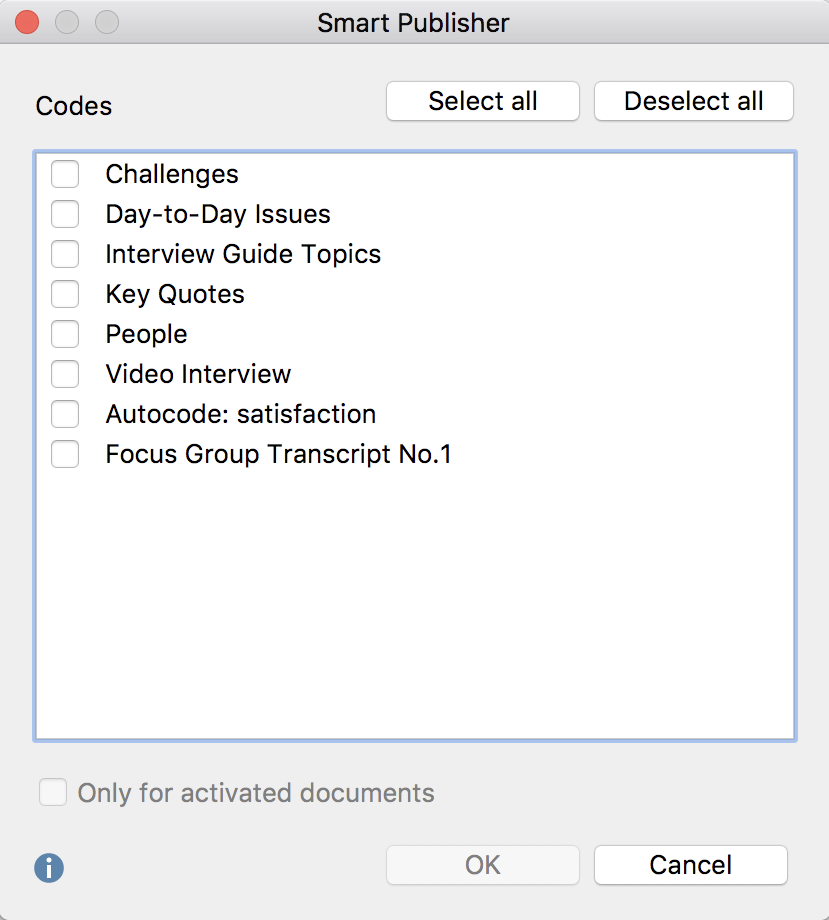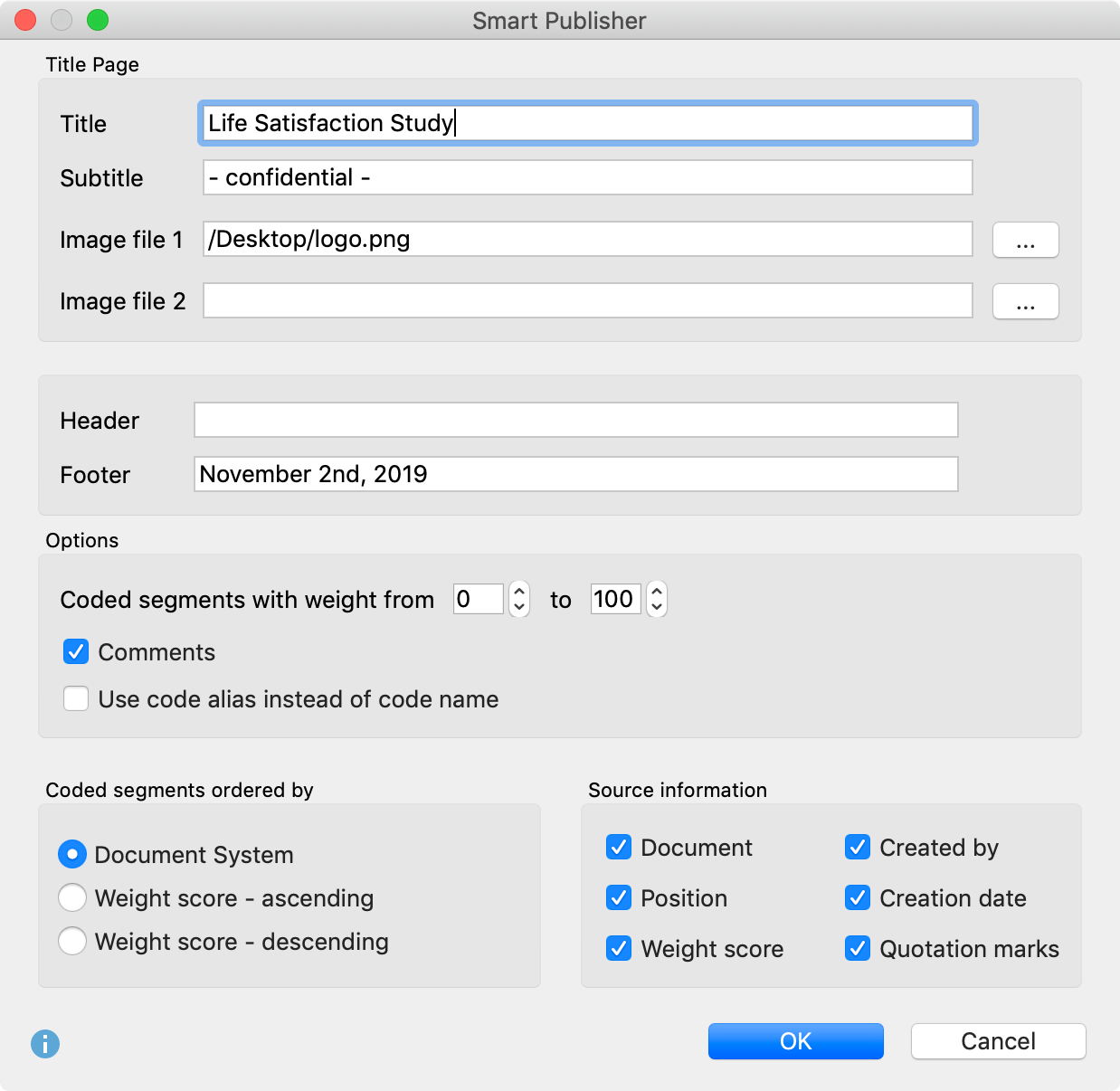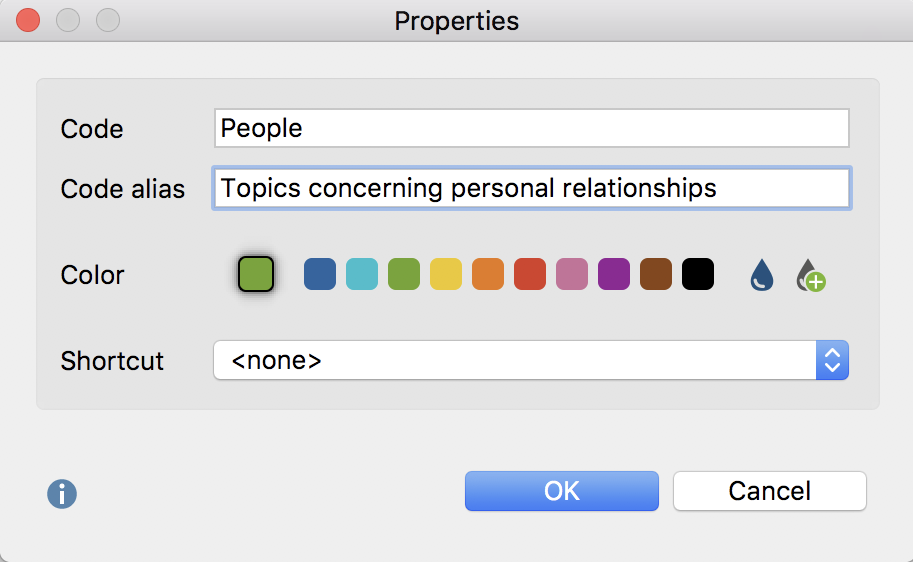Smart Publisher is a convenient report generator. It exports selected retrieved segments in a formatted Word document report, including title page and table of contents. The structure of the report is determined by the “Code System:”
- An individual chapter will be created for each top-level code.
- A subchapter will be created for each subcode.
- Coded Segments of each code form the content of each (sub)chapter.
Opening the Smart Publisher
Smart Publisher can be accessed via the main ribbon menu: Reports > Smart Publisher.

When Smart Publisher is called up, a dialog window will appear in which you can select the codes to be included in the report. When top-level codes are selected, their corresponding subcodes will automatically be included in the report. You can also choose to include coded segments only from activated documents.

Smart Publisher settings
The following dialog window displays the various report options:

“Title“ settings
Title – The title, which will appear on the first page of the report.
Subtitle – The subtitle, which will appear on the first page of the report.
Image files 1 and 2 – Selection of up to 2 image files, which will appear on the first page of the report. If the field is left blank, no image will appear.
”Header and Footer” settings
Reports can be formatted to include headers and footers, which will appear on each page after the title page.
Header – Header text
Footer – Footer text
“Options” settings
You can limit the output to segments where a weight was assigned in a defined area.
Comment – Below a coded segment, its comment is also output.
Use code alias instead of code name – The code alias will be used in the place of the code name as a heading, if defined for the respective code (see Creating a Code Alias).
“Coded Segments sorted by” settings
In this part you can set how the coded segments within each chapter of the report are sorted. You can sort segments by their documents position in the ”Document Sysetm” or by their assigned weight scores.
“Source information” settings
In the “Source information” you will find numerous options for the information to be included for each coded segment.
Document – Displays document group and document name.
Position – Displays the beginning and the end of the coded segment (as well as paragraph numbers for textual data).
Weight Score – Displays the weight of the coded segments.
Created by – Displays the name of the user who coded the segments.
Creation date – Displays the date on which the segments were coded.
Quotation marks – text segment will be placed in quotation marks
The following figure shows an extract from a report that was generated using Smart Publisher. The displayed segment comes from the paragraphs 35-36 of the document “Jon” from the document group “New York.” It was encoded with a weight of 100. The segment was assigned the code “Significantly Positive:”

The report
The finished report is in the form of a Word document (for Windows in DOCX format, for Mac in RTF format), which includes a title page, table of contents, a page that lists of all the documents included in the report, and the main section including all of the exported segments. If a header/footer was included, it will appear on all pages aside from the title page. If an end page was included, it will appear at the end of the report.
All elements of the report are formatted using the Word template (DOT format). Formatting of the final report can be modified; for example, you can easily insert additional pages or content.
Alias names for codes
Smart Publisher uses the code names from the “Code System” as headings for the individual subchapters of the report. However, you may wish to assign an alternate name to some or all of the subchapters in the report. This may be the case if the 63 characters per heading allowed by the system are not enough, and you wish to create a longer name, or if, in other cases, a shorter heading would be more appropriate. For this reason, MAXQDA allows you to create a “code alias” of up to 225 characters.
In order to assign a code alias, right-click on the code in the “Code System” and select “Properties”. A dialog window will appear, in which you can enter the code alias.

From the menu Codes > Code alias table you can call up a table, in which you can conveniently create code aliases for multiple codes, and can see for which codes a code alias has been assigned.

Adjusting the Smart Publisher layout
It is possible to customize the layout of Smart Publisher reports (under Windows). To do this, you will find a settings file, the contents of which you can customize. You can find the file here:
Windows: local installation
1. Press the windows key + R
2. Insert the following path and press "Ok": %appdata%/MAXQDA2020
Windows: portable installation on USB stick
(Flash Drive)\MAXQDA 2020 Portable for Windows\Resources
The file in which you can change the appearance of all used styles is "SP_Formats.ini". The structure for each element is as follows:
[Default_Format]
StyleName = "MQ_Header1"
FontName="Calibri"
FontSize = 11
LineSpacing = 1.2
SpaceAfter = 6
Indent = 12.5
For example, to use your the font that is used in your corporate design, change the entry next to FontName from "Calibri" to the appropriate text font.
